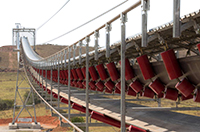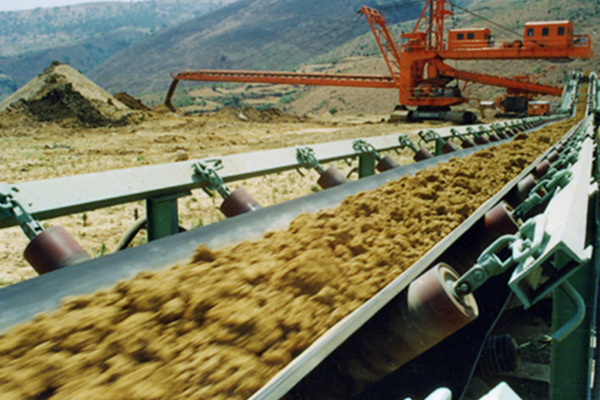The cleaner plays an important role on the conveyor. It can promptly and quickly remove the residual materials sticking to the conveyor belt, avoiding it from being brought back to the return branch, causing dirt on the surface-increasing roller and return roller, and causing belt wear , Deviation, etc., and avoid the danger of casualties caused by manual removal of attachments. This article analyzes 10 belt conveyor cleaners with different structures, so that you can make correct and appropriate selections.
1. Scraper cleaner
The scraper cleaner uses the gravity of the counterweight or the elastic force of the boom to make the scraper fixed on the boom come into close contact with the working surface of the conveyor belt to remove residual materials on it. According to the number of scrapers, it can be divided into single, double and multiple scrapers. The scraper materials are rubber, cemented carbide, ceramics, etc.
The scraper cleaner is simple in structure, convenient to replace the scraper, and has a good cleaning effect. It is generally installed at the discharge roller to clean the materials attached to the conveyor belt. It is suitable for cleaning the conveyor belt with vulcanized joints.
2. Rotary cleaner
The rotary cleaner is composed of an independently driven main shaft and a hard brush or scraper mounted on it. The hard bristle brush is made of nylon, etc., and the scraper is made of rubber or hard alloy.
The high-speed rotation direction of the rotary cleaner is opposite to the running direction of the conveyor belt (the linear speed of the brush or scraper is not less than 10m/s). The brush or scraper not only cleans the conveyor belt directly, but also because of its high speed. A low pressure area is formed at the front to enhance the cleaning effect.
This kind of cleaner is often installed at the head and tail rollers of the conveyor to clean powdery granular materials.
3. Vibration cleaner
Vibrating cleaners are often installed on the return branch of the conveyor. They are suitable for belt conveyors with various conveyor belt joints and can clean up viscous materials. A vibrating cleaning device composed of several alternately arranged idlers, welds many steel rods equal in length to the idlers along the circumference of the idlers. When the conveyor belt passes between the idlers, vibration is caused by the action of the steel rods to remove residuals. materials.
Another kind of cleaning device with vibration, its vibration frequency is adjustable, and the cleaning effect is better. In order to achieve good results, the frequency is controlled at the natural vibration frequency of the conveyor belt to be cleaned.
4. Spiral cleaner
The spiral cleaner uses the rotation of the rolling body to continuously change the position of the spiral relative to the conveyor belt to achieve the cleaning purpose. The cleaner has strong cleaning ability and can remove materials on the conveyor belt in harsh environments.
5. Brush cleaner
The brush cleaner uses the movement of the brush to clean the residual materials on the conveyor belt.
The brush of the cylindrical brush cleaner is made of nylon and is installed under the roller. It can be dragged by the roller (or independently). The pressure of the brush on the conveyor belt can be adjusted by moving the position of the weight. The cleaner is suitable for Cleaning of dry powder materials.
The wet crawler brush cleaner is suitable for cleaning under wet and sewage treatment conditions.
Conveyor brush cleaner is composed of driving device, brush head, tail roller, intermediate pressure roller, etc., which clean the conveyor belt horizontally to facilitate the removal of cleaning materials.
6. Water spray cleaner
The water spray cleaner is suitable for conveying materials that are not afraid of dampness, and the water source is sufficient and there is a sewage system. For example, the transportation of concrete in dams, the dredging of rivers, and the sludge transportation in hydraulic engineering can use water spray cleaners. The conveyor belt is cleaned by pressurized water and the effect is very good.
7. Empty section cleaner
In the process of conveying materials on the conveyor belt, it is inevitable that the material will be scattered due to the deviation of the conveyor belt, causing the material to fall on the return section of the conveyor belt.
The empty section cleaner is often installed on the upper side of the return branch conveyor belt, close to the tail roller, used to clean the materials scattered on the return branch conveyor belt, and prevent materials from being caught between the conveyor belt and the tail roller, damaging the roller and the conveyor belt, and affecting The normal operation of the conveyor.
8. Combined cleaning device
When transporting viscous materials, a cleaning device often cannot completely clean the conveyor belt, and a combined cleaning device can be used.
The combined cleaning device shown in the figure (a) below first washes the conveyor belt with a water jet, then the conveyor belt passes through the pool, and then is washed with a brush and scraper in turn, and finally the conveyor belt is dried.
The combined cleaning device shown in the figure (b) below consists of a water conservancy cleaning pipe, a cleaning roller, a cleaning scraper, etc. First, the conveyor belt is washed by water, and then the conveyor belt is cleaned by the cleaning roller and the cleaning scraper, and the cleaned material and mud mixture is discharged from the mud pipe.
9. Conveyor belt flip cleaning method
Conveyor belt turnover cleaning method is suitable for cleaning long-distance conveyors. Its cleaning mechanism is that the return branch of the conveyor belt is turned 180° after leaving the head drum, and then turned 180° to restore the original state before entering the tail drum. So as to prevent the residual material from falling and blocking the space under the conveyor and sticking to the return branch roller.
10. Conveyor belt cleaner
The conveyor belt cleaner is designed according to the width of the conveyor belt. The cleaner consists of two parts, which are installed under the unloading roller of the machine head and under the conveyor belt at the overlap of the machine head and the H frame.
When the belt conveyor unloads materials, in order to prevent coal, water and mud stuck on the top belt from entering the belt conveyor, under the unloading roller of the machine head, two cleaners are added to clean the materials on the top conveyor belt for the first time. The cleaning is not complete, and the conveyor belt runs to the junction of the machine head and the H frame, and starts to clean up again, so that the adhesion is removed.
The performance of the cleaner of the belt conveyor directly affects the performance and service life of the belt conveyor. The structure of the cleaner should be appropriately selected according to the characteristics of the conveyed material and the specific use conditions. The combined use of multiple types of cleaners can improve the cleaning effect.








